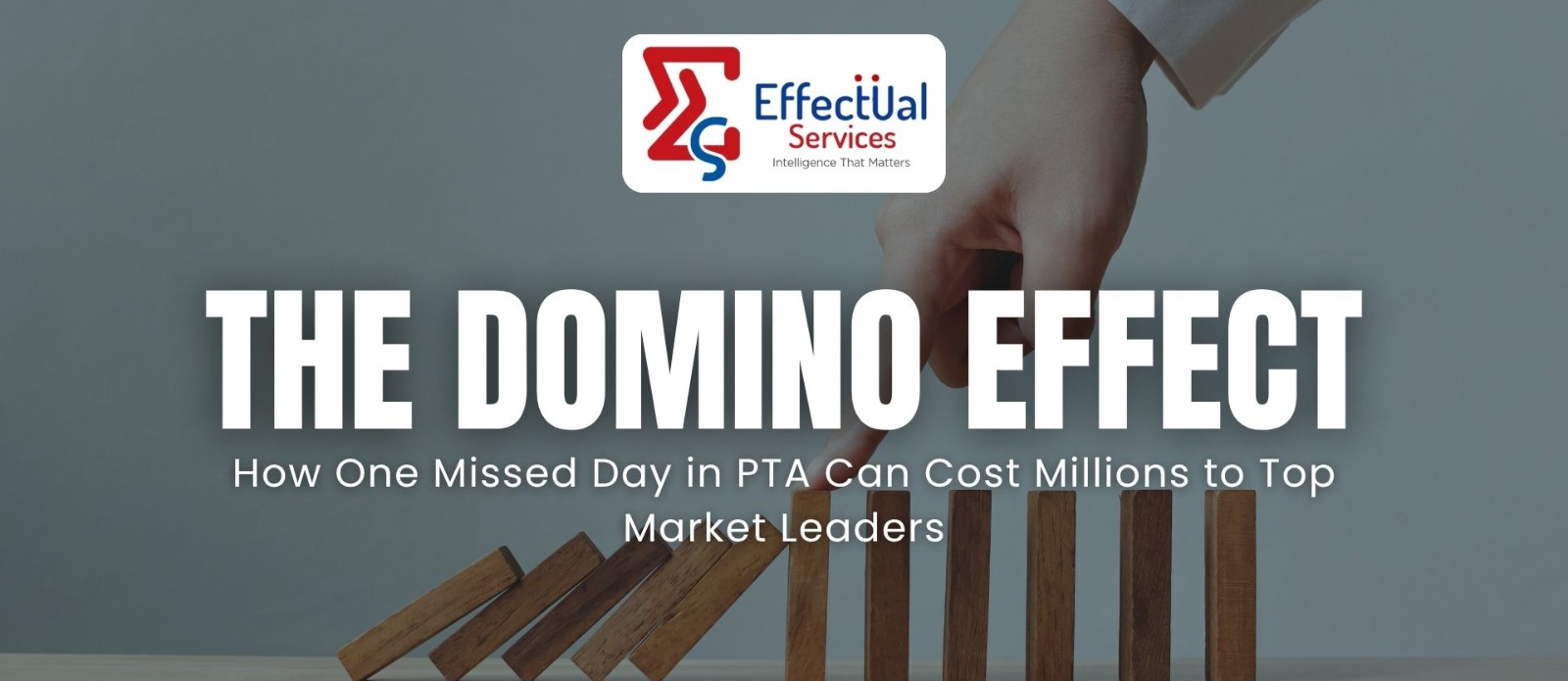The Domino Effect: How One Missed Day in PTA Can Cost Millions to Top Market Leaders

In the passionately competitive world of intellectual property (IP), accuracy is supreme. Every day, thousands of patent applications move through global patent offices, and for modernizers at the top of their industries, each day signifies potential revenue, competitive edge, and shareholder value. Patent Term Adjustment (PTA), a mechanism designed to compensate patentees for delays in the examination process may seem like a part procedural concern. But when overlooked or mismanaged, even by a single day, the financial repercussions can ripple outward like falling dominos.
This article will discover how one day of lost PTA can cost millions, why top market leaders are particularly exposed, and how a robust approach to PTA diligence has become a critical pillar of present IP management.
Understanding Patent Term Adjustment
Before examining into the consequences, it is essential to understand what PTA entails. In the United States, the standard patent term is 20 years from the earliest effective filing date. However, delays attributable to the United States Patent and Trademark Office (USPTO), such as the time taken to issue the first office action, respond to appeals, or adjust after successful administrative or judicial review can tyrannize an applicant’s effective patent term.
To neutralize these administrative delays, Congress enacted PTA under 35 U.S.C. §154(b), granting additional days to the patent term. These adjustments fall into three main categories:
- USPTO delays in issuing office actions within 14 months of filing.
- Failure to issue a patent within three years.
- Delays causing from appeals, interventions, or secrecy orders.
The Financial Stakes of a Single Day
At first glance, the loss of one day may sound minor. But in reality, a single day in the life of a blockbuster patent can be worth an unanticipated sum.
Consider a pharmaceutical company that has magnificently patented a life-saving drug. Throughout the patent’s exclusivity, competitors are legally banded from introducing generic substitutes. Even a single day of additional exceptionality can yield huge revenues. According to estimates published by the U.S. Federal Trade Commission, bestseller drugs can generate between $1 million to $10 million per day in protected sales. For biologics, the number can be even higher.
In the technology sector, the stakes are no less substantial. A telecommunications patent covering a standard-essential technology might underlie licensing agreements with dozens of manufacturers. If royalties average $1 million per day across all licensees, losing a day of PTA directly translates to a million dollars of unrealized revenue.
Nevertheless, the cost does not stop there. Loss of PTA can:
- Allow competitors to go into the market prior, accelerating price erosion.
- Negotiations with licensees who monitor patent expiry closely.
- Fail the company’s leverage in breach disputes.
- Unsettle revenue estimates and, in publicly traded firms, shareholder confidence.
This is the reason why market leaders treat PTA management with the same importance as product development itself.
The Domino Effect in Action
The Broader Significances:
- Market Entry: Competitors instantly proclaim plans to launch generic substitutions the day after patent expiry.
- Legal Disclosure: Competitors file pre-launch declaratory judgment actions, accelerating litigation timelines.
- Negotiation Dynamics: Licensees renegotiate royalties downward, citing abridged exclusivity value. This is not a rare outlier IP strategists see comparable situations regularly, and it is why many companies have implemented elaborate checks, specialized software, and dedicated teams solely to monitor PTA deadlines.
Why Top Market Leaders Are Especially Exposed
Some may assume that only small or midsize companies are vulnerable to PTA missteps. In reality, the conflicting is true: the more valuable a patent, the higher the exposure. Here’s why:
- Scale of Revenue: Market leaders own products and platforms that create massive revenue streams. Even niche enhancements like a formulation patent or process patent can be worth millions per day.
- Global Licensing Dependencies: Large enterprises often depend on complex, multi-layered licensing models. Expiry triggers renegotiation or termination of dozens of agreements.
- Market Signalling: Patent expiry dates are chased not only by competitors but also by investors and analysts. A limitation term sends a signal of liability.
- Litigation Leverage: In litigation, the length of exclusivity affects settlement dynamics. Shorter patents may encourage defendants to resist settlement, prolonging costly litigation.
- Operational Complexity: The more patents a company prosecutes, the greater the likelihood of administrative oversights.
Indeed, as the IP portfolios of top companies have expanded, PTA tracking has moved from a paralegal task to a core strategic function overseen by directors of IP operations.
The Role of Technology in PTA Management
Spotting the stakes, many organizations have implemented technology solutions to decrease the risk of human error. PTA management tools have evolved expressively in recent years, incorporating:
- Automated Docketing: Docketing platforms calculate PTA deadlines and alert teams to upcoming indicators.
- Integrated Workflows: These platforms integrate with document management systems, ensuring filings are listed and verified in real time.
- Validation Protocols: Many solutions cross-reference USPTO records to approve accurate calculations.
- Audit Trails: Every action is timestamped and attributed, creating an evidentiary record for internal audits or litigation defences.
- Forecast Modelling: Some tools model the potential revenue impact of lost PTA days, making the stakes visible to business leaders.
Adoption of such tools is no longer optional for high-revenue patent portfolios, it is a baseline expectation for any company seeking to protect shareholder value.
Best Practices to Prevent PTA Loss
While technology plays a critical role, process discipline remains equally vital. Marketplace leaders employ a mixture of policies and cultural norms to ensure PTA veracity:
- Redundant Deadline Analyses: Deadlines are reviewed and confirmed by at minimum two independent team associates.
- Clear Standard Operating Procedures: Written protocols define each step in the filing and response procedure.
- Escalation Protocols: Potential uncertainties or calendar inconsistencies are escalated promptly to supervising attorneys.
- Ongoing Training: Teams receive periodic training on PTA rules and latest legal developments.
- Periodic Audits: Internal audits are conducted to authenticate that PTA is correctly calculated and that no inadvertent delays have occurred.
- Strategic Counseling: Business teams are accomplished on the financial impact of PTA loss so that suitable resources are allocated.
These practices not only safeguard revenue but also signal to investors, courts, and competitors that the company manages its intellectual property with rigor.
The Evolving Legal Landscape
The implication of PTA has improved as courts and regulators refine the framework governing patent term adjustments. In cases such as Wyeth v. Kappos, the Federal Circuit clarified that intersecting delays (e.g., A and B delays occurring concurrently) are not cumulative bring about in less PTA than many applicants expected. In analogous, USPTO rules require applicants to enthusiastically monitor and, where necessary, challenge PTA determinations. If an applicant disagrees with the USPTO’s calculation, they must file a request for reconsideration within a strict period or forfeit the right to correct the error.
This changing landscape underscores the importance of maintaining refined PTA tracking practices and staying well-informed of legal developments.
Beyond Compliance: The Strategic Edge
While much of the focus around PTA centres on loss anticipation, forward-thinking companies recognize that proactive PTA management is also a source of strategic advantage.
By capitalize on PTA:
- Revenue Streams Are Extended: Even modest adjustments can add weeks or months of exclusivity, translating to significant incremental profits.
- Negotiation Leverage Is Boosted: In licensing discussions, the prospect of longer uniqueness supports premium royalties.
- Competitor Entry Is Delayed: Rivals must wait longer to enter the market, extending first-mover advantages.
- Investor Confidence Is Strengthened: Consistent protection of IP effects demonstrates operational excellence and reduces perceived risk.
The cumulative effect of these advantages can differentiate a company from competitors who approach PTA reactively rather than strategically.
Conclusion
In an era when patents form the strength of business strategy, the significance of a single day cannot be inflated. What seems like an inconsequential administrative oversight can falls into a domino effect unleashing lost revenues, accelerated competition, renegotiated contracts, and investor unease.
Market leaders understand that PTA diligence is not a clerical detail, it is a core aspect of fiduciary responsibility. Protecting every day of patent term requires a combination of:
- The right technology,
- Clear processes,
- A culture of accountability, and
- Strategic foresight.
For companies that succeed in embedding PTA vigilance into their IP DNA, each day retained is another day to serve patients, advance innovation, reward shareholders, and maintain leadership in the marketplace. When measured against these stakes, the investment in PTA discipline is not just prudent, it is indispensable.
About Effectual
At Effectual Services, we provide increased efficiency, adaptability, and access to a broader talent pool while maintaining the accuracy and security of client’s data. PTA calculation ensures that patent owners receive fair compensation for examination delays and administrative issues beyond their control. It extends the patent term, increases the value of patents, and provides incentives for efficient patent examination processes, benefiting patent applicants, patent owners, and the overall intellectual property landscape.
Solutions Driving Innovation & Intelligence
Enabling Fortune 500's, R&D Giants, Law firms, Universities, Research institutes & SME's Around The Globe Gather Intelligence That
Protects and Nurtures Innovation Through a Team of 250+ Techno Legal Professionals.

